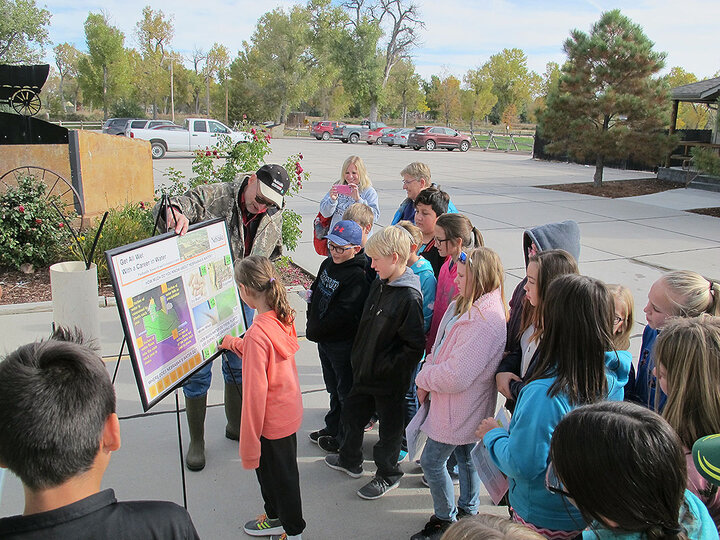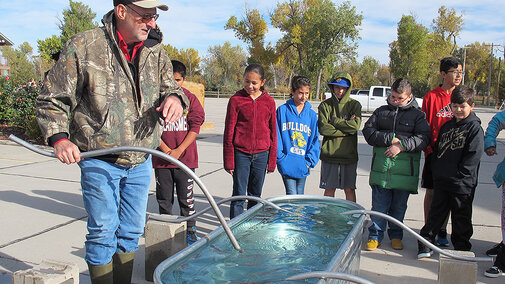“Digging into Extension”, a CropWatch feature series, shines a spotlight on the professionals of Nebraska Extension, highlighting their roles in extension and services they provide to Nebraska farmers and ranchers. We hope you enjoy getting to know your local Nebraska Extension educators and specialists while reading Digging into Extension!
It’s been said “Cattle are king” in the Nebraska Panhandle, but they’re not the only hot commodity out west.
In thirsty fields from Sioux to Deuel County, Gary Stone is checking rain gauges and soil water sensors, and waiting to see how much water the crops use every day. For Stone, water is king, and it’s been the primary focus of his career as a Nebraska Extension educator.
“Helping irrigators in the Panhandle is a challenge,” Stone said. “Being in a semi-arid growing area with limited annual precipitation of 14 to 16 inches per year, the Panhandle irrigators have a unique situation with irrigation water management.”
It’s a situation that’s all too familiar to Stone, who grew up on a farm just outside Mitchell, Nebraska. As an ag youth, he spent a lot of time tending the alfalfa and corn fields that fed their cattle — especially when it came time to dig and set the irrigation tubes.
So, years later, when the chance came to help his neighbors and other Panhandle farmers with their water issues and efficiencies, Stone was eager to the task. He accepted an extension educator position at the UNL Panhandle Research Extension and Education Center in 2007 and jumped right into his first special project — Pumpkin Creek.
A Focus on Water
The Pumpkin Creek Project was created to address the complex issue of water in western Nebraska, where Panhandle farmers have strict irrigation pumping allocations. Pumpkin Creek farmers, for instance, get an allocation of 12 inches of water a year. And if they use even an inch over their share, they have to pay it back twofold — in water.
Stone’s project devised ways for Panhandle farmers to use less water and avoid the hefty penalties of exceeding their allocations.
With help from local farmers, Stone and his colleagues investigated a myriad of solutions for using less water, including alternative crops, crop water sensors and no-till practices.
“It was a good project that worked out,” Stone said. “Three growers we worked with still use no-till and are managing their water much better.”
He also worked on another water project in his first years — METRIC, a statewide collaborative study with the University of Idaho that employed satellites to monitor crop water use. In this project, Stone said, they used satellite images to analyze a crop’s heat production and then calculated its Consumptive Water Use (CWU). METRIC was also a success, and the method is still used today to assist farmers with understanding and managing their water use.
Currently, Stone is working on another prominent water study focused on encouraging growers’ adoption and use of crop sensors for improved water management.
This irrigation project is led by UNL Water and Irrigation Management Specialist Dr. Xin Qiao through the Panhandle Learning Agriculture Network (PLAN), based at UNL PHREC. Coordinating with on-farm research participants, PLAN researchers are in the third year of monitoring soil water sensors and crop sensors in 23 fields, with real-time water use data displayed for not only the research team, but also the farmers involved in the project.
“The beauty of the project is that all the participating growers can view their counterparts’ fields to see how they are managing their irrigation water,” Stone said. “With this interaction, growers can learn from each other.”
The Extension Gamut
Though he started as a special projects educator, Stone’s position evolved over time and today he’s one of the many Nebraska Extension educators juggling a myriad of studies with finesse.
From the growers and residents of his Panhandle extension territory (Sioux, Dawes, Sheridan, Box Butte, Garden, Deuel, Kimball, Cheyenne and Banner counties), Stone fields calls about trees, lawns and gardens, and shares his advice on weed management in crop fields and rangelands. He also manages the Nebraska Master Gardener Program.

He’s handy at identifying mysterious plants and insects, too — like that one time a local chicory grower brought in a skittering sample, worried he had an impending flea beetle invasion. But Stone’s sleuthing proved the pests to be a species of wood-boring beetles, just living large on a pile of old wooden pallets on the farm.
“I enjoy that — getting something like that out of the blue, and you think it’s one thing and find out it’s entirely different,” Stone said, chuckling. “We solved the problem. He learned something, I learned something.
“My favorite part of the job is helping people find answers to their problems. Seeing the look on their faces when they say, “Oh!” You can just see the lightbulb go on.”
Drawing from his well of water expertise, Stone also teaches area growers how to use evapotranspiration and soil water sensors on their farms, and assembles a weekly crop water use report to help them make crucial water application decisions.
Stone covers a lot of bases in the ag world out west, and as the weather gets warmer, he knows the calls, emails and drop-ins will start to flood in — it’s growing season. He’s ready. He loves it.
“It’s a never-ending day of questions that people have for you,” Stone said, laughing warmly. “It’s just the people. It’s the clients. It’s their problems. You solve a problem or find an answer. You find out if (your suggestions) worked for them. It’s rewarding.”
Gary Stone is an extension educator for Sioux, Dawes, Sheridan, Box Butte, Garden, Deuel, Kimball, Cheyenne and Banner counties. To connect with him, email gstone2@unl.edu or call 308-632-1480.

